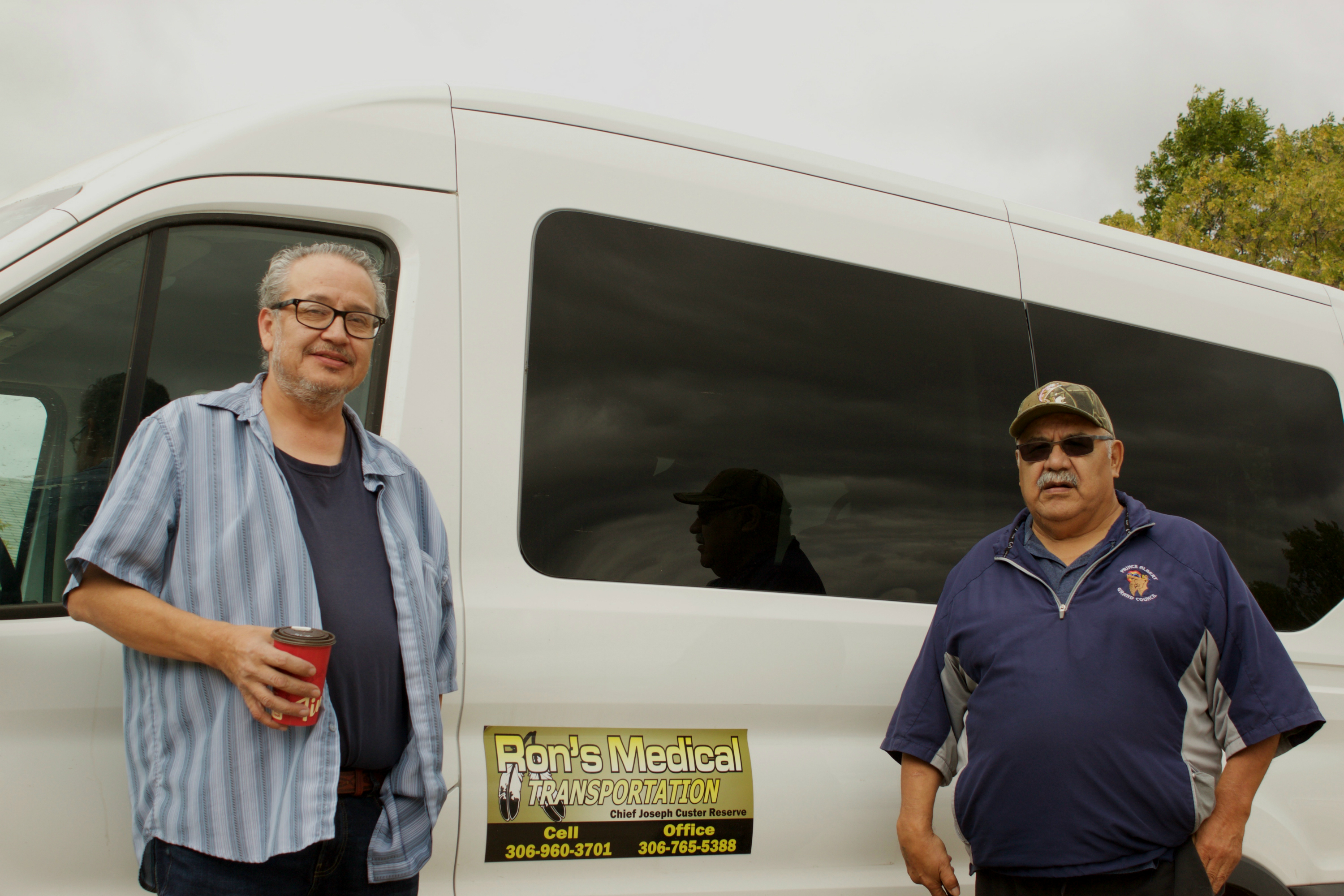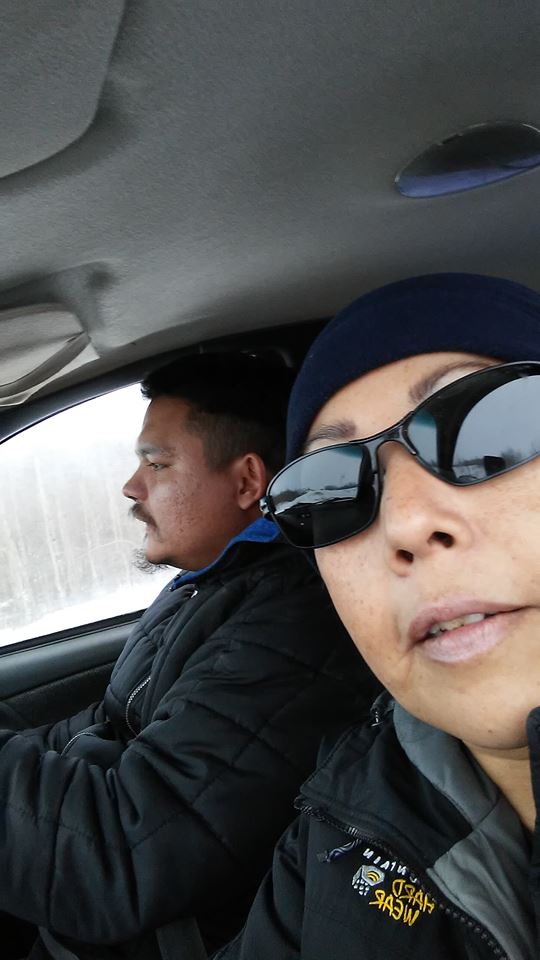Loading and offloading
How do seniors, who are either unable or unwilling to drive on the highway, get to Saskatoon? They find somebody living nearby, and pay them. That’s what Leona Sather, 85, has had to do.
“It’s a bugger,” she said.
Sather has lived in Watrous, a town in Central Saskatchewan about 110 kilometres southeast of Saskatoon, since 1951. She came to find work, got married, and has lived there ever since. Sather said she doesn’t ask just anybody to drive her – if would have to be somebody she knew.
“I had to go up to Saskatoon on Monday. I had an eye appointment with a specialist. I found a girl in town that would drive my car. But that’s a damn nuisance too.” Sather said.
While she owns a car, and considers herself lucky enough to be able to drive to the grocery store in town, it isn’t safe for Sather to drive on the highway.
“If it came to the worst, I have a daughter who lives in town but I hate to pull them off work to take me in. It’s damn hard,” Sather said.
Litman has studied small rural communities with aging populations who recognized the need for drivers and organized volunteer driving pools in local church or social service agencies. He said they don’t offer a long-term substitute for a regular bus service for several practical reasons. Even the most committed ride-givers get burnt out, are unable to dedicate the time required, and can’t meet the demand for rides very long. These social service agencies discovered that they need paid drivers dedicated, trained professionals with maintained vehicles. A paid driver “becomes a savior for those people who need to make those trips,” Litman said.
When the STC ran a route from Watrous to Saskatoon, Sather rode it once every two months. To her, “it’s very upsetting” that the bus is no longer an option.
“If I could get my hands on the guys that did it I’d choke them,” Sather said.
“If I could get my hands on the guys that did it I’d choke them.”
– Leona Sather
“Why couldn’t they have cut it down to once a week? I never went into the city just for fun.”
Sather isn’t socially isolated, but her network is mostly fellow residents of Westbridge Manor, a senior’s complex. “They’re all in the same boat as me – up in age,” she said. She was talking about her building, but she could just as easily have been talking about all small towns in Saskatchewan, where populations are aging, and millennials are trailing out.
Between 2006 and 2011, the proportion of the population living in rural areas in Saskatchewan dropped from 35 per cent to 33 per cent, according to Statistics Canada.
In a study on rural populations in Saskatchewan, economist Bakhtiar Moazzami noted that the declining and aging of rural populations boils down to the young people between the ages of 20 and 30 moving away.
What will happen to smaller communities in Saskatchewan, now more isolated than ever?
“Small towns are dying, so people need to work together to be something instead of falling apart,” said Robert Weleski, 63, who also lives in Watrous. “They’re not saving nothing when they close everything down.”
For the average person approaching retirement and considering a scenario in which they cannot drive, communities that fail to provide public transportation are bound to see their populations continue to nose-dive.
“We’re basically saying, when you can no longer drive, you’ve got to move out, because we don’t serve your type. That’s what the move by the provincial government to stop supporting rural bus service is saying: non-drivers are not important to us,” said Litman.
Finding and funding another way
One First Nation council in Saskatchewan responded to the loss of the STC by establishing its own transportation service.
Ron’s Medical Transport, created by former chief of the Prince Albert Grand Council in 2018 Ron Michel, carries Grand Council members to and from medical appointments in Saskatoon.
While it requires resources from a group of First Nations communities to operate, the service is funded through Health Canada and Indigenous Services.
It is only available to members of the twelve First Nations represented by the Tribal Council, and only to members travelling for medical reasons.
Michel, 66, said that he came out of retirement because he was “tired of reruns on TV.” But Ron’s Medical was actually inspired by what Michel called “the STC crisis.”
“Our government decided it needed to handle its own transportation. When the STC stepped down, people had to change their transportation, use taxi cabs,” he said. Many Indigenous people are wary of taxi and Uber drivers (recently approved for operation in some Saskatchewan cities), and a one-way taxi ride from a remote community can cost ten times that of a bus ride.
“We were starting to contract taxis in the city, and it was getting to be a problem for some of our First Nations who had a language barrier, and the care wasn’t there as it should be when you’re sick. You’re sick – you can’t be in a crowded vehicle. Especially in the smoking department,” Michel said, referring to one of the potential side-effects of ride-shares.
After serving in leadership positions – as chief, councillor and manager – for 40 years, Michel said his knowledge of federal programs for First Nations made it possible.
“And we as First Nations have to get into those things in order for us to accommodate our own people. It’s something that we have to start taking care of ourselves,” he said.

Manager and driver George McLeod and Ron Michel (right) at Spruce Lodge in Prince Albert. [Photo © Lisa Johnson]
Michel runs a fleet of five vans, one with wheelchair access, and two SUVs. The service caters mostly to dialysis patients, heart and stroke patients, and cancer patients, and Michel has hired some drivers that speak Dene or Cree.
Ron’s Medical demanded a $200,000 start-up investment in passenger vans, a cost council deemed a necessity.
“There were a lot of people that were missing appointments. I wouldn’t want to see a cancer patient or a dialysis patient hitchhiking. I think the community leadership has seen the need, and there aren’t too many doctors that go out into the community,” he said.
Michel takes pride in the fact that his passengers, many of whom were forced to missed appointments, can now arrive safely, he said.
It’s up to individual communities in the Grand Council to bring passengers to Prince Albert, where Ron’s Medical then takes them to as many as 150 appointments in Prince Albert and Saskatoon per day.
And, Michel said that the need to access health care is only going to increase in these communities.
“First Nations are growing, and at the same time there are a lot of health problems. Diabetes, heart and stroke and cancer are starting to lead in ailments that are happening in our communities. Mental health, alcohol and drugs are really getting to our people.”
Vicky Dagneault, who has come to rely on ride shares to get in and out of Prince Albert, has escorted her mother a few times to see a specialist in Saskatoon, and believes that if Ron’s Transport were expanded, it could provide much-needed transportation for people who need it.
“Visiting family, kin, is really important among Aboriginal people.”
– Loreena Gardipy
But transportation needs go well beyond just medical or government service appointments, said Loreena Gardipy, a former income assistance administrator at Red Pheasant First Nation. Red Pheasant is a small reserve roughly 30 minutes south of North Battleford, a city on Highway 16 that connects Saskatoon to Edmonton.
Gardipy has been a social worker for 20 years, and said she knows the dynamics of how people get around.
“Visiting family, kin, is really important among Aboriginal people. Family means a lot – and the bus system was right there to get from one place to another. For funerals for wakes, for the birth of a baby, for spiritual things, stuff like that, it was really accessible,” she said.
When the STC route operated, the community didn’t have direct service, but it connected nearby North Battleford to other major cities in the North West.
And there are particular barriers for those who live on reserve, she said.
Indigenous Affairs covers medical cabs that can get people to Saskatoon from North Battleford through its non-insured health benefits program for eligible First Nations, but Gardipy said that sometimes they are booked or full. There are priority patients, like those who are on dialysis, and people sometimes miss appointments or don’t make trips because there is no public transportation, Gardipy said.
Ultimately, the loss of options for travelling beyond Highway 16 – particularly North to Meadow Lake – has created practical obstacles. “I really feel that a lot of our people within our communities do have a lot of hardship because they relied on that transportation. A lot of people have so many barriers from health to having no driver’s licence,” Gardipy said.
“With STC, it was so much easier to get to Meadow Lake [and] all the remote communities because the bus used to stop [in North Battleford], so many things stopped as a result.”
You still had to hire people or catch a ride from Red Pheasant, but STC routes travelling north to Meadow Lake, which is roughly 150 km north of North Battleford, connected Flying Dust First Nation, Moosomin First Nation, and Makwa Sahgaiehcan First Nation at Loon Lake – all on one highway loop in Treaty Six territory.
“It ruined a lot for a lot of people. Why did they take it? It’s so inconvenient for everybody,” she said.
Members of Red Pheasant First Nation with medical needs still face serious challenges, and don’t have the benefit of Ron’s Medical Transport.
Here, as in other remote communities, social media has become essential for getting a ride. The going rate to hire a ride from Red Pheasant to North Battleford is $40, Gardipy said.
“There are people putting on Facebook “’Who is going from North Battleford to Saskatoon?’ because they have to see their doctors. People are in a really vulnerable situation right now,” Gardipy said. Locking down a ride, and ensuring that it waits for you, remains a challenge.
Some simply forego appointments, saying “’Well I can’t even get to Saskatoon and I can’t find anyone to drive me,’ so they don’t go,” she said.
People in this part of the province who are able to reach North Battleford are relatively lucky in Saskatchewan. Beginning in late 2018, Rider Express began running a route six days a week along Highway 16, filling the gap left by the Greyhound. Rates held steady, too, at $30 for a trip to Saskatoon. But that hasn’t changed the fact that pedestrians are still hitting the highway.
Before Greyhound pulled out of the area, there were still people hitchhiking along Highway 16. Having recently picked up an elderly woman walking on the road from the reserve, Gardipy knows that people in the community are isolated.
“It’s so hard living in Saskatchewan,” she said.

Leona Bird and Jordan Paul in Feb. 2019. [Photo © Leona Bird]
Bird and Paul, long-time hitchhikers on Highway 2 north of Prince Albert, pooled their money together. It was difficult to find an affordable, reliable car, but by Feb. 2019, they managed to do so.
“We got wheels. $340 for a Chevy Cavalier. It’s a good start,” Bird said.